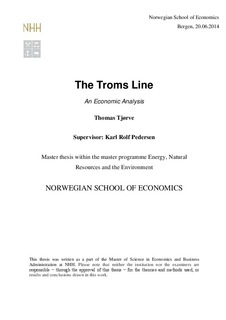| dc.description.abstract | The aim of this thesis is to bring the old assessments regarding the Troms Line back to life again, and examine whether it would be a good idea, from an economic point of view, to revive the project.
When examining the regional conditions, it is evident that there is one factor that has changed, and is expected to change more in the coming years. This is the mined volumes of minerals, especially in Sweden, but also in Finland. The most notable of course being iron ore. In conjunction with withdrawing ice, and the gradual opening of the Northeast Passage, the connection of the largest city in the region – Tromsø – to the rail network would, in some aspects, seem reasonable.
The thesis bases its analysis on the guide provided by the National Rail Administration and the values it provides, and derives numbers regarding the current traffic in the region from the National Public Roads Administration and published statistics by Statistics Norway.
The shortage of potential passengers in the region is acknowledged as the main cause for the project being found to be very unprofitable. There were two separate route alternatives being examined, both following the same route from Narvik to Andselv. From Andselv, one alternative is primarily based on bridge-building and crosses Malangen on its way to Tromsø. The second alternative passes through Nordkjosbotn and follows the Balsfjord on its way to Tromsø. The first alternative was found to be the most profitable, but even with very beneficial scenarios examined in the performed sensitivity analyses, there seems to be no basis to recommend such a considerable investment.
The thesis therefore concludes with a recommendation of not pursuing the project, with one exception: If the increasing demand for shipping cannot be covered by the port in Narvik, or other bottlenecks, the willingness-to-pay by foreign interest could be assumed to be quite high, as alternatives are scarce and significantly more costly. A co-funding of some kind, by private or/and public foreign interests could render an otherwise unprofitable project to become profitable. | nb_NO |
